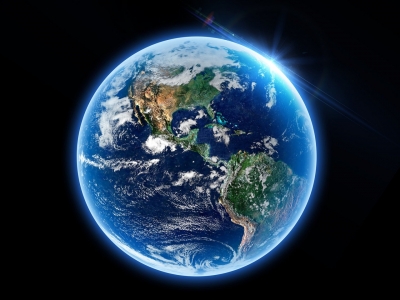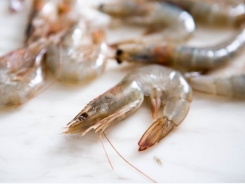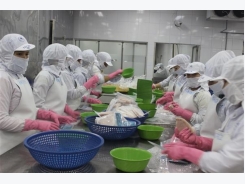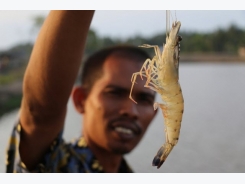We can meet our planets protein needs with aquaculture

Spinning through history, seafood industry veteran Phil Walsh is reminded that farmed fish is the way forward
Bill Bryson’s brilliant book, “A Short History of Nearly Everything” (Broadway Books, 2003), should be mandatory reading for anyone about to start college. At the very least, it will give new undergraduates a profound sense of gratitude for the experience that lies ahead, make them glad they’re alive and perhaps even allow them to understand the importance of their own existence.
Chapter headings like Lost In The Cosmos, The New Age Dawns and The Bounding Main are introduced with notable quotes, such as, “A physicist is the atom’s way of thinking about atoms,” by anonymous; and “Nature and nature’s laws lay hid in night; God said, Let Newton Be! And all was light,” by Alexander Pope.
The strain of understanding the scientific breakthroughs Bryson speaks to are interspersed with wonderful comic relief, usually in the form of detailed descriptions of the eccentricities of those who’ve made significant scientific discoveries, like Henry Cavendish (1731-1810), without question the most gifted scientist of his time.
Notoriously shy, those who approached Cavendish to seek his views on their discoveries at the few scientific gatherings he attended were advised to “…wander into his vicinity as if by accident and to talk, as it were, into vacancy.” If their remarks had merit, they might receive a mumbled reply, but they would, more often than not, “…hear a peeved squeak and turn to find an actual vacancy and the sight of Cavendish fleeing for a more peaceful corner.”
Eventually, Bryson’s unending stream of astounding facts ventured even closer to my world: “There are 320 million cubic miles of water on Earth and that is all we’re ever going to get. The system is closed; practically speaking, nothing can be added or subtracted. The water you drink has been around doing its job since the Earth was young.” He later adds, “Of the 3 percent of Earth’s water that is fresh, most exists as ice sheets. Only the tiniest amount – 0.036 percent – is found in lakes, rivers and reservoirs.” So much for the Great Lakes!
There’s no question from any scientific corner that domesticated livestock and fowl cannot begin to address our world’s near-term protein needs, and that aquaculture is our best option.
And in The Bounding Main, Bryson tells us what we’d rather not know – that for 10 years the U.S. government dumped 55-gallon drums of radioactive waste in the waters surrounding Northern California’s Farallon Islands, home to 18 species of whales and dolphins. I went the Woods Hole Oceanographic Institution http://www.whoi.edu a few weeks back to see the Alvin, our nation’s fabled submersible, and fell into a conversation with a man who’s been a crewmember of the Atlantis, the naval vessel that transports the Alvin to distant waters, for over 20 years – and who told me he’d had a firsthand look at these drums last year on a descent.
He said that “…for about two feet around each one, in a perfect circle, the mud surrounding each drum is of a different color and consistency than the rest of the mud on the seabed.” Pollution and extractive industries have also done untold damage to our oceans, as evidenced by the 2010 Deepwater Horizon oil spill in the Gulf of Mexico.
Bryson also tells us that as of 1995 (the book is dated, unfortunately), some 37,000 industrial-sized factory trawlers, plus a million smaller boats, were taking twice as much fish from the sea than had been harvested 25 years prior. My own experience at a U.S. Coast Guard Search and Rescue Station on an island off the coast of Massachusetts in the early 1970s bears this out. Looking east from Nantucket, bright lights from foreign ships extended across the entire horizon every night. Let me assure you, making your way through the distant water fleet, these virtual floating cities, to medevac an injured crewman was no simple task.
Having blown a hole in the ozone layer, we’re now doing the same thing to the tectonic plates we live on. “Fracking” may well help our balance of trade and keep petrol prices down, but the process of injecting liquid at high pressure into subterranean rocks to force open existing fissures and extract oil or gas has an unknown downside, the size of which we cannot fathom, as we’re in uncharted waters. The number of 3.0 magnitude (or higher) quakes in Oklahoma rose from 41 in 2010 to more than 900 in 2015, according to the U.S. Geological Survey. Our tectonic plates float on Earth’s core of molten lava, and some think it might be wise to listen to our planet, particularly when she speaks to us so bluntly.
We’ve had five major extinction events in the last 450,000 years, and are now at the tail end of a warming period that’s lasted longer than most. The effect of releasing more than 30 billion tons of carbon into our wafer-thin atmosphere every year is incalculable.
We are the most intelligent beings ever to inhabit this planet. Technology, only recently released from religious constraints, has made great achievements. We’ve eradicated diseases that routinely killed us, we’ve doubled our capacity for advancement in every field by enabling women to (almost) fully partake in our endeavors and we cut the world poverty rate in half during the last 20 years. But we haven’t quite figured out how to sustainably feed ourselves yet, have we?
Shortly before his death, Apple Founder Steve Jobs said, “I think the biggest innovations of the 21st century will be at the intersection of biology and technology. A new era is beginning.” While this prospect frightens some, the sound, scientific minds among us understand that applying technology to biology has shown us that recent developments in aquaculture present us with the ability to feed our world’s growing population, a problem that stood without a solution for many years. We’re good people, most of us, but we’re capable of great mischief, particularly when we choose to ignore the implications of short-term gains. We’ve plundered, poisoned and pillaged our fragile planet as if to hasten the next extinction event, and the time to stop and begin working together is upon us.
We are gods; we may as well get good at it. – unknown.
We domesticated livestock and tamed the grasses some 10,000 years ago, and while aquaculture dates back some 5,000 years, the technology to make it capable of feeding the world didn’t exist until recently. I have the honor of teaching at the Rosenstiel School of Marine and Atmospheric Science, the hands-down leader in the development of modern aquaculture, and we know what this industry is capable of.
There’s no question from any scientific corner that domesticated livestock and fowl cannot begin to address our world’s near-term protein needs, and that aquaculture is our best option. The decimation of wild caught species has gone beyond the point of debate and probably recovery, yet there remains an almost superstitious opposition to aquaculture from an otherwise evolved demographic. Getting more public support is critical to the success of aquaculture, just as the success of aquaculture is critical to the success of our species.
About Author:
PHILIP C. WALSH
In addition to directing nationally recognized seafood programs at Kings Supermarkets, Harris Teeter Supermarkets and Stop & Shop Supermarkets, where he pioneered retail sustainability programs in 2000 by partnering with the New England Aquarium, Phil Walsh introduced successful fresh seafood programs at Porky Products, Inc., DiCarlo Foods and Ritter Sysco Foodservices, New York Metro’s dominant protein distributors. Walsh now serves as VP at St. Andrews USA. He also teaches a graduate course in seafood marketing at the University of Miami’s Rosenstiel School of Marine and Atmospheric Science, and authored Isle of Shoals in 2013.
Related news
Tools

Phối trộn thức ăn chăn nuôi

Pha dung dịch thủy canh

Định mức cho tôm ăn

Phối trộn phân bón NPK

Xác định tỷ lệ tôm sống

Chuyển đổi đơn vị phân bón

Xác định công suất sục khí

Chuyển đổi đơn vị tôm

Tính diện tích nhà kính

Tính thể tích ao




 We’re no longer nomads, so we should farm…
We’re no longer nomads, so we should farm…  Loans offered to shrimp farmers cooperating with enterprises
Loans offered to shrimp farmers cooperating with enterprises